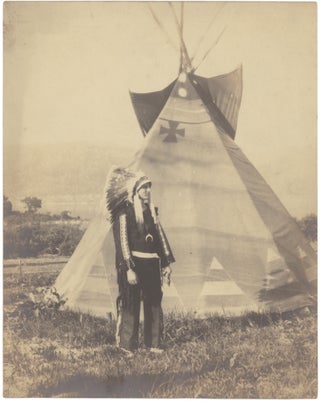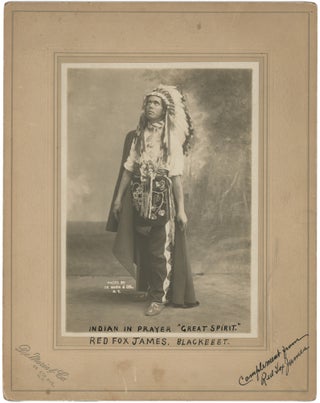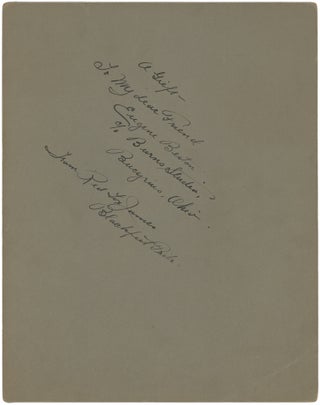Three Photographs of Reverend Red Fox James, One Inscribed.
New York, et al: 1915. Silver gelatin prints, roughly 8 x 8, 8 x 10 and 5 x 7 inches, the last on a larger mount. Very Good. Item #CAT0127
In 1914, Francis Red Fox James, now presumed to be related to the Blackfoot tribe, rode a horse across the country seeking states’ approval for an American Indian national holiday. He delivered endorsements from 24 states to the federal government, but a commemoration never materialized. The Washington Herald reported that James rode 4,000 miles from a Crow reservation in Montana and was received by President Wilson to discuss the possibility of a “national Indian’s Day” in October. (Washington Herald, 12/16/14)
Although his mother was probably Blackfoot, James claimed Native American heritage only as an adult. He changed his name by adding “Red” and later “Skiuhushu” to Francis Fox James. Two of the images in this collection contain familiar tropes of American Indian portraiture but the third offers an arresting image of James holding the American flag aloft as a kind of offering. This enigmatic gesture could be read as evidence of an optimistic belief in a mutual relationship between the US and American-Indian nations. It is also undoubtedly related to James’ interest in legitimizing his Indian heritage as the founder of the Tepee Order, a youth organization addressed mainly to white Protestant children. By 1920 the Order had evolved into an adult secret fraternal organization, shrouded in mysticism. James was also associated with the Boy Scouts; he is credited with organizing the first All-Indian Boy Scout Troop in 1915.
In The Search for an American Indian Identity (1970) Hazel Hertzberg writes that James “was deeply troubled by his degree of Indian ‘blood.’” In addition to changing his name several times to seem more “Indian,” he theorized that his Welsh ancestry was pre-Columbian, using the Tepee Order to create a kind of third space, a “pan-Indian society” that was neither Indian nor white.
We find no other examples of these photographs, though a US flag does appear on James’ saddle in a photo documenting his White House visit. One picture signed by James, with “Indian in Prayer “Great Spirit. / Red Fox James. Blackfeet.” on recto and the following on verso: “A Gift / To my dear Friend / Eugene Beaton (?) / c/o Burns Studio / Bucyrius (sic), Ohio. From Red Fox James / Blackfoot Tribe.” Generally a very good collection with some fading to images, but well preserved overall.
Price: $750.00






